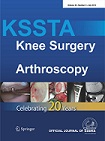
SHOULDER & ELBOW
Postoperative analgesic effect of multimodal shoulder injection after rotator cuff repair
Knee Surg Sports Traumatol Arthrosc. 2013 Dec;21(12):2877-83. doi: 10.1007/s00167-012-2202-4. Epub 2012 Sep 1970 patients with full thickness rotator cuff tears undergoing arthroscopic repair were randomized to compare the postoperative analgesic effect of multimodal shoulder injection to intravenous patient-controlled analgesia (IV PCA). Participants were allocated to one of the described postoperative analgesia methods, and were assessed during the first 48 hours after surgery. Pain in the first 2 hours was significantly reduced in the multimodal shoulder injection group comparatively, and was similar to the IV PCA group thereafter. However, the use of rescue analgesics was more often needed in the multimodal shoulder injection group during 12-48 hours post-surgery. Overall patient satisfaction was similar between the two groups. Additionally, multimodal shoulder injection was associated with reduced postoperative nausea, and cost less per patient than IV PCA.
Unlock the full ACE Report
You have access to {0} free articles per month.Click below to unlock and view this {1}
Unlock NowCritical appraisals of the latest, high-impact randomized controlled trials and systematic reviews in orthopaedics
Access to OrthoEvidence podcast content, including collaborations with the Journal of Bone and Joint Surgery, interviews with internationally recognized surgeons, and roundtable discussions on orthopaedic news and topics
Subscription to The Pulse, a twice-weekly evidence-based newsletter designed to help you make better clinical decisions
Exclusive access to original content articles, including in-house systematic reviews, and articles on health research methods and hot orthopaedic topics
Or upgrade today and gain access to all OrthoEvidence content for just $1.99 per week.
Already have an account? Log in


Subscribe to "The Pulse"
Evidence-Based Orthopaedics direct to your inbox.
{0} of {1} free articles
Become an OrthoEvidence Premium Member. Expand your perspective with high-quality evidence.
Upgrade Now












































































